by John Alder | Aug 25, 2017 | Bundesliga, German football stories
The new football season in Germany has started with controversy.
The ceremony of the opening second division game between VfL Bochum and FC St Pauli was drowned by loud booing, whistling and chanting.
At the start of all the opening Bundesliga games, fans from opposing teams united to abuse the football authorities (DFB) with chants of “Scheiß DFB”. Home fans unfurled banners spelling out grievances and threatening future action.
So what is making German football fans so unhappy?
Commercialisation
In theory, German football clubs are ‘owned’ by their fans. The “50+1” rule means that an individual or a company cannot control a club. Fans are directly involved in the running of their clubs. German football fans are proud of the traditional values of the game. They believe football is about much more than maximising profits and cite retention of standing areas in every ground and reasonable ticket prices as examples of the benefits of this approach.
They are worried about creeping commercialisation. The purchase by multinational Red Bull of a lower league club, which has led to the inexorable rise of Red Bull Leipzig appears to have by-passed the 50+1 rule. Fans believe Red Bull is simply using the football club to market its brand.
Similarly, there is no way village club Hoffenheim would have achieved Bundesliga status and success without the heavy investment of local billionaire Dieter Hopp.
And now Hannover 96 has applied for an exemption to the 50+1 rule so that President Martin Kind can own a majority share in the club.
Some fan groups are suspicious of the decision to allow a Chinese team U-20 team to compete in fourth tier Regionalliga Süd West. Although this will earn welcome cash for all teams in this league, it also gives the impression that football is being used to further commercial and political interests.
Fixtures scheduled to suit TV and not supporters
Fixtures are now spread over a full weekend and timings appear to be set at the convenience of sponsors and broadcasters rather than supporters. Since exact schedules are only announced a few weeks ahead it is very difficult for fans to plan. And sometimes it can be impossible for them to get to games. For example, VfL Bochum fans had to travel to Armenia Bielefeld on Monday 21 August for an 8.30pm kick-off.
On top of that, traditional fans really don’t like the non-traditional ‘entertainment’ now appearing at some grounds, which has nothing to do with football and appears to be aimed at people not even at the game.
Collective punishments
On several occasions last season the DFB imposed collective punishments on large groups of fans. When Dortmund played RB Leipzig last season a small number of Dortmund ‘Ultras’ attempted to block the away team bus and assaulted visiting supports. As a punishment the DFB ordered Dortmund to shut down the entire block for the next home game, effectively punishing 25,000 fans for the actions of a few.
Intrusive security
The football authorities are increasingly concerned about fan violence inside and outside grounds and the continued use of pyrotechnics by some fan groups. This has led to the introduction of personalised tickets and identity checks at turnstiles. For obvious historical reasons state intrusion into personal privacy is a highly sensitive issue in Germany
What next?
DFB President Reinhard Grindel appears to be listening. He has stated that there will be no more collective punishments and is seeking renewed dialogue with fan groups to address their concerns. He has also recognised that the success of German football is built on the commitment, loyalty and passion of supporters.
His statement has been welcomed by fan groups, but many fans remain highly suspicious of official motives and are still not convinced they are being taken seriously. Most commentators expect hostilities to continue throughout the season.
Find out more about German football
by John Alder | May 23, 2016 | German football stories
Unless you are a Bayern Munich fan you don’t expect your football life to be one long victory parade. You know that only one team can win the league, that teams can go up as well as down and that there will always be more losers than winners. What really, really hurts is hope that is then dashed.
- You hope that a 89th minute equaliser means that a dreadful run of results is about to end – but then they lose again the next week.
- You hope that a couple of scrappy wins mean a place in the play-offs is still a possibility – but then two defeats on the bounce put it just beyond reach.
- You hope that if the results go your way, and if your boys can beat the team that hasn’t won away all season and hasn’t scored a goal since Easter, you might just avoid the drop – and of course none of that happens and you end up deeper in the mire.
Record breakers
So spare a thought for the poor fans of MSV Duisburg. Founder members of the Bundesliga when it was formed in 1963, the Zebras (they play in black and white stripes) were a force to be reckoned with well into the 1980s. Since then their fans have endured misery piled on misery. Disappointing performances on the the pitch and constant financial worries are not unusual for football clubs, but Duisburg fans must have a record for having hopes raised and then cruelly dashed.
Exhilarating and successful promotion campaigns have been followed by demoralising and unsuccessful fights against relegation. Cup final appearances in 1975, 1998 and 2011 all ended in defeats. In 2013 a late run of good results and an 11th place finish appeared to have saved the Zebras from yet another relegation. But mistakes in financial documents submitted to the league meant that the club was denied a licence and relegated to the third division. Hope returned the next season in the form of an immediate fightback to the the second tier. This was then slowly eroded as the 2015/16 season got underway by what seemed like a never-ending run of poor performances.
Relegation looms again
When Duisburg lost 2:1 at home to Heidenheim on 1 April, relegation seemed certain. With 6 games to go they were bottom of the table, with a meagre 19 points. They had only won three times all season. They still had to play FC Nürnberg, SC Freiburg and RB Leipzig – the three teams most likely to win promotion to the Bundesliga.
Hope returns – but only for a while
But in the space of two weeks total despair turned to slight hope. They beat Nürnberg 1:2, and the next week won 2:1 at home to 1860 München. Although still bottom of the league, safety was now within reach. A happy end to the season was possible.
So guess what happened next? Of course – a heavy 3:0 away defeat to SC Freiburg.
An inspiring fightback
But the torment went on. Next up were local rivals Fortuna Düsseldorf – also fighting relegation. Always a hotly contested derby game, this one was even more heated than usual – and Duisburg won 2:1.
So thousands of poor Duisburg fans travelled to the next game, against SV Sandhausen, with hope renewed. And of course, by half time their team was trailing 1:0 and second goal in the 75th minute appeared to have put the match and hope of staying up well beyond the Zebras. But then two goals in a stirring final ten minutes meant Duisburg went home with one point and hopes still just alive. One more win would see them finish the season third from bottom – high enough to avoid automatic relegation and to earn a playoff against whoever finished third in the division below. Unfortunately, the last game of the season was against RB Leipzig, who had already secured promotion to the Bundesliga and had only lost 5 games all season.
Defiant to the end
28,209 desperate fans turned up to cheer on their team. The Duisburg players put up a spirited and defiant performance, determined to do their very best. But with 15 minutes to go neither side had scored. Everyone knew that a draw would not be enough and the Duisburg fans must have begun to fear the worst. But then, in the 75th minute, Giorgi Chanturia made a brilliant run, surging through the Leipzig defence to put the ball past the keeper and spark wild scenes of celebration. Staunch defending for the last few minutes kept the score at 1:0. This victory meant that automatic relegation was avoided. Their fate was now in their own hands. Victory over two relegation/promotion playoff games against Würzburger Kickers would secure their place in the second division.
Disaster once again
The first game was on Friday 20 May. 3000 Duisburg fans – hope now burning – made the journey south for the first leg. Thousands more watched the game on live TV. After 10 minutes KIngsley Onuegbu’s very high foot caught Würzburg’s Peter Kurzweg on the head. The home team scored the ensuing penalty. Duisburg’s misery was deepened further when captain and central defender Bajic was given his 10th yellow card of the season and meant he would miss the home leg of the tie. A second goal in the 80th minute put the game beyond Duisburg’s reach. Hope was not completely extinguished, but to cling on to 2 division status they would need to score three goals in the home game.
On 24 May MSV Duisburg began this final battle well. Cheered on by a capacity home crowd the players seemed determined to get an early goal. And in the 33rd minute an own goal by Würzburg’s Schoppenhauer gave the Zebras the lead and sparked delighted celebrations around the ground. Sadly, this joy was to last a mere four minutes before Soriano found himself in the penalty area, one-on-one with the keeper. And of course he scored. Duisburg never really recovered from this devastating blow, Try as they might, they could not break through the Würzburg lines. Duisburg’s misery was then compounded by the sending off of Obinna for dissent and a second goal for Würzburg in the 92nd minute. MSV Duisburg were back in the 3rd division
As their dejected fans made their way home they must surely have asked themselves whether it would have been better to have lost to Nürnberg and 1860 München and to have known their fate back in April. But they will be back next season. And a few decent wins early on will raise hopes of yet another fightback …..
by John Alder | May 19, 2016 | German football stories
Five years ago this month marks the final chapter of one of the most exciting Bundesliga comeback stories ever. It’s the story of how Borussia Mönchengladbach stepped back from the brink of relegation.
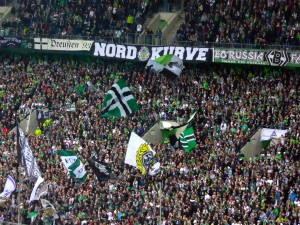
A dreadful season
The 2010/11 season had begun disastrously for the Borussen. By February 2011 they had collected only 16 points from 22 games and had conceded 56 goals. They hadn’t won at home for 9 games.They were bottom of the league and 7 points from safety. The transfer window was closed and relegation seemed unavoidable. In February 2011 a new coach was appointed who was to bring about a remarkable transformation in fortunes. His name was Lucien Favre.
Last minute fightback
His appointment led to an immediate improvement in form. In the next 12 games the team accrued 20 points, conceded a paltry 9 goals and won five of the last 8 home games. It was enough to shift them to third from bottom and avoid automatic relegation.
Although they had to do now to secure top tier status was to beat local rivals VfL Bochum over two relegation/promotion games.
Last gasp winner
On 19 May 2011 Borussia faced Bochum in front of a capacity home crowd. The score remained 0:0 for the full 90 minutes. It was only in the 3rd minute of added time that the home side eventually broke the deadlock. A long throw into the box was carried on by a header. A second header from Camargo was parried to the side by the keeper with a fingertip save. The cross back across goal was mis-controlled by players from both sides until finally a shot at point blank range from Camargo put the ball over the line. The crowd went wild, the Bochum players sank to the ground in despair. A few seconds later the first leg was over – Borussia had won 1:0. There is a video of the dramatic last seconds of this game on Facebook.
In the second leg Borussia trailed for most of the match following an own-goal in the 24th minute from Nordweidt. But with 18 minutes remaining Marco Reus scored. Borussia Mönchengladbach won 2:1 on aggregate and remained in the top tier.
Click below to find out more about Borussia Mönchengladbach
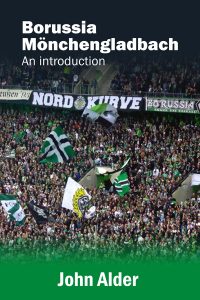
by John Alder | Feb 12, 2016 | German football stories, Uncategorized
Schalke 04 was one of Germany’s first truly working class football clubs. Players and fans came from the same town – Gelsenkirchen – and most from the Schalke district itself. This is where the miners and their families lived, worked and played. The club’s first stadium – the Glückauf-Kampfbahn – was built here. The triumphs of the 1920s and 1930s were celebrated on these streets. On match days the road from the Schalker Markt to the ground was a sea of blue and white.
Since then much has changed. De-industrialisation has brought the district into steep decline. The community of old is no more and the area has a run down feel to it. The club moved three kilometres to the north many years ago – first to the Parkstadion and then into the shiny new Veltins Arena. Now just the unremarkable suburb of an industrial city, it’s hard to imagine what it must have been like here during Schalke’s glory days.
But many fans still cherish Schalke’s roots. They remember that Schalke is a place as well as a club. They lament the fact that you can support the modern Schalke 04 without ever setting foot in the part of town whose name the club carries, and without knowing about its origins and history.
Fan Project Schalker Meile
In 2006 a a group of fans got together to do something about this – to make sure that this part of town and it history are not forgotten. They wanted to create a second royal blue haven.
And so the project Schalker Meile was born. The idea was fill a stretch of the road between the old Schalker Markt and the original Glückauf stadium – the route once walked by hundreds of thousands of fans – with as many reminders of Schalke 04 as possible.
Electricity pylons were painted in the club colours and empty shop windows decorated with signs. Banners and posters were put up. Local businesses were encouraged to adapt their branding to make reference to the club. The tram stop in the middle was renamed ‘Schalker Meile’ and the entire street was transformed into a blue and white tribute to Schalke, with key historic buildings signposted.
The main sights
In the m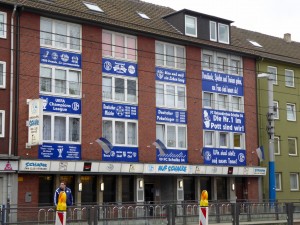 iddle there is a pub called ‘Auf Schalke’ which is run by the Schalke fan club (90,000 members),
iddle there is a pub called ‘Auf Schalke’ which is run by the Schalke fan club (90,000 members),
and there is a fan shop nearby.
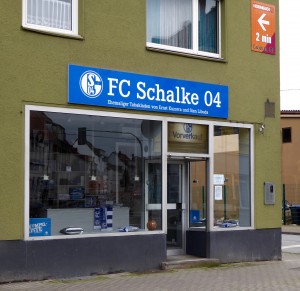
A bit further along you pass the tobacconist shop which until 1974 was run by former player Ernst Kuzorra, and then was taken over by another Schalke legend – Stan Libuda.
Towards the end of the Meile and right next to the old stadium there is another pub called ‘das 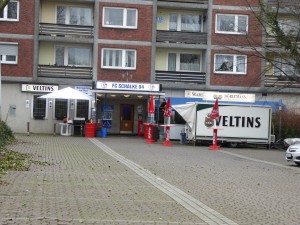 Bosch’. This is where the players used to drink. A sign indicates Ernst Kuzorra’s regular seat. It’s now the home of a fan group called ‘Kuzorras grandchildren’, as well as pub of choice on match days of countless Schalke fans.
Bosch’. This is where the players used to drink. A sign indicates Ernst Kuzorra’s regular seat. It’s now the home of a fan group called ‘Kuzorras grandchildren’, as well as pub of choice on match days of countless Schalke fans.
And finally you arrive at the old Glückauf-Kampfbahn. Although looking sadly run down, it is still in use for youth games, and still undoubtedly ‘Schalke’.
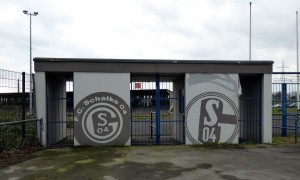
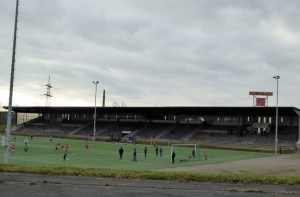
The yellow house appears
The impact of this tribute to Schalke’s past and present is huge. Thousands of people travel up and down this street every day. On match days, trams and buses take fans along it on their way to and from Veltins Arena. Many stop off for a while to have a drink with friends. It has become a place of pride for residents and visitors alike.
So it is easy to imagine the dismay when, in April 2015, one of the biggest buildings, right in the middle, almost opposite the Auf Schalke pub, was painted bright yellow – the colour of arch rivals Dortmund.
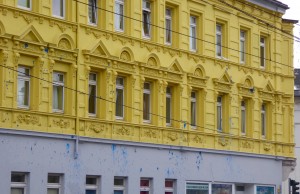 More reasonable fans suggested that, as the owner was from Holland, he might have not understood the implications of his choice of colour. But others were outraged and later the same year the building was daubed in blue and white paint. Again, local reaction was mixed. Some people argued that any attack on private property was wrong, others that as every other surface had elements of blue and white it was only to be expected.
More reasonable fans suggested that, as the owner was from Holland, he might have not understood the implications of his choice of colour. But others were outraged and later the same year the building was daubed in blue and white paint. Again, local reaction was mixed. Some people argued that any attack on private property was wrong, others that as every other surface had elements of blue and white it was only to be expected.
What next?
Everyone agrees that the current situation cannot continue. It’s hard to see, however, how things can be resolved. The owner is completely within his rights to paint the building yellow, but even the most mildest, reasonable of local people are very upset at the impact of this building on their street.
The solution might lie in the club’s origins. The very first Schalke team from 1904 wore yellow and red shirts – so maybe a sensible compromise would be to paint the lower half of the building red and agree that the colours are a gesture to the club’s founders.
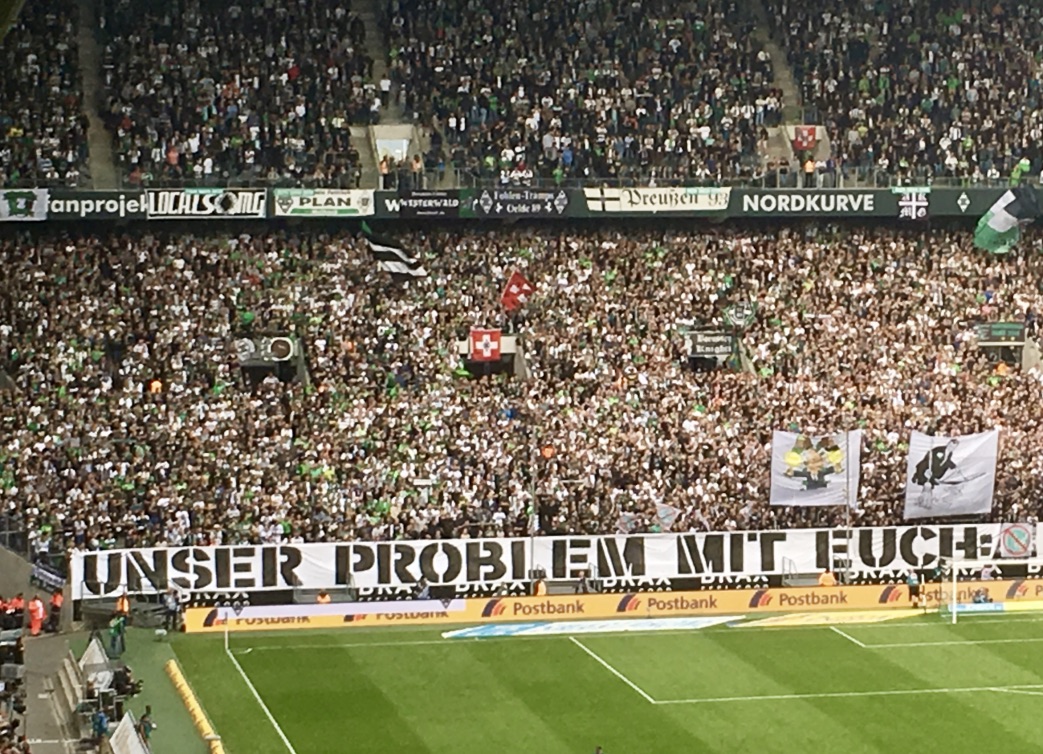
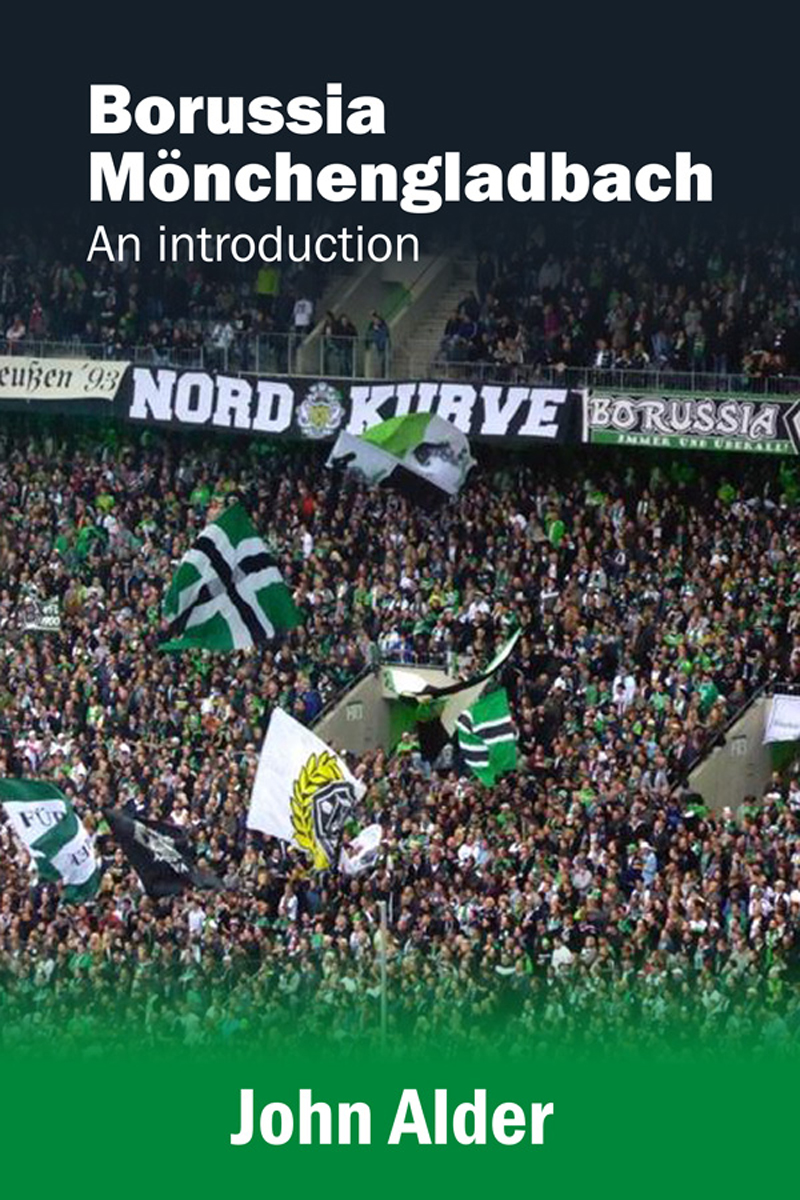
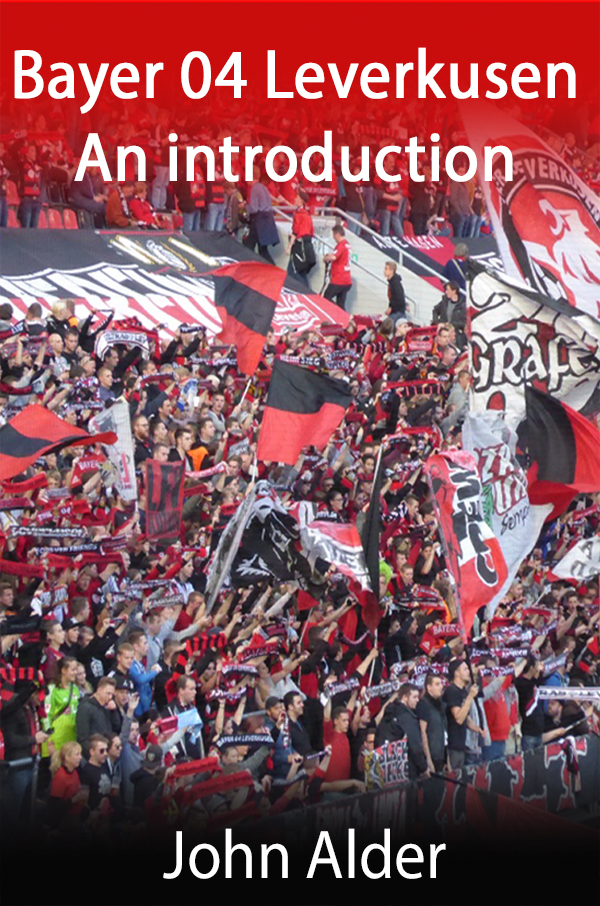
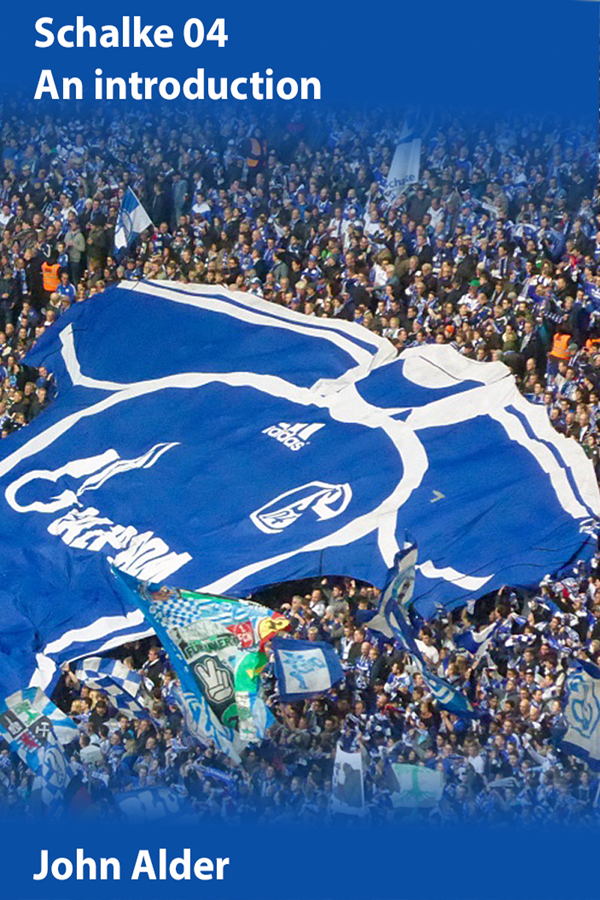
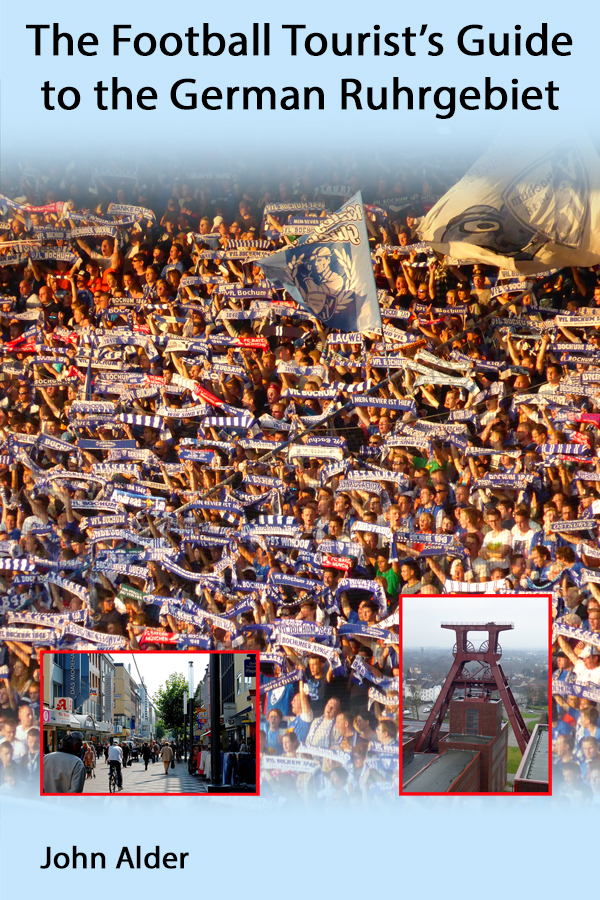


 iddle there is a pub called ‘Auf Schalke’ which is run by the Schalke fan club (90,000 members),
iddle there is a pub called ‘Auf Schalke’ which is run by the Schalke fan club (90,000 members),
 Bosch’. This is where the players used to drink. A sign indicates Ernst Kuzorra’s regular seat. It’s now the home of a fan group called ‘Kuzorras grandchildren’, as well as pub of choice on match days of countless Schalke fans.
Bosch’. This is where the players used to drink. A sign indicates Ernst Kuzorra’s regular seat. It’s now the home of a fan group called ‘Kuzorras grandchildren’, as well as pub of choice on match days of countless Schalke fans.

 More reasonable fans suggested that, as the owner was from Holland, he might have not understood the implications of his choice of colour. But others were outraged and later the same year the building was daubed in blue and white paint. Again, local reaction was mixed. Some people argued that any attack on private property was wrong, others that as every other surface had elements of blue and white it was only to be expected.
More reasonable fans suggested that, as the owner was from Holland, he might have not understood the implications of his choice of colour. But others were outraged and later the same year the building was daubed in blue and white paint. Again, local reaction was mixed. Some people argued that any attack on private property was wrong, others that as every other surface had elements of blue and white it was only to be expected.